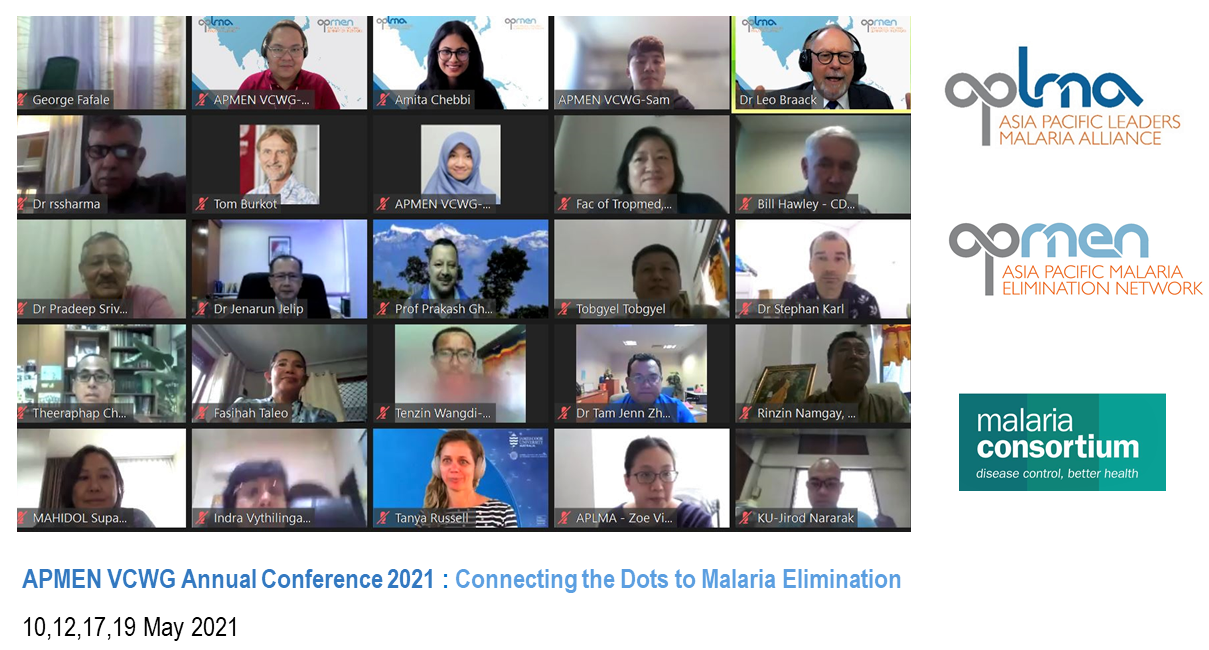
After a hiatus of more than two years, the annual conference of the APMEN Vector Control Working Group was resuscitated and recently concluded with great success! In keeping with Covid-19 realities, it was a Virtual Conference, but well attended by our vector control community in Asia Pacific and indeed participants from across the world. To accommodate the busy schedule of most people, we spread the conference over four days, taking up the afternoons (in Asia at least!) of 10, 12, 17 and 19 May. It was heart-warming to see the enthusiasm and loyalty of our VCWG audience, with upwards of 150 persons participating on most days.
Our central theme for this year was Vector Surveillance Training Needs Assessment, to which we devoted three afternoons, and the final afternoon to exploring how Private Sector can be more effectively deployed towards malaria elimination.
Day 1 was a scene-setter for discussions in days ahead, with presentations showing results of a survey on Vector Surveillance Capacity (Drs Burkot/Russel), and vector control practices in India (Dr Baruah) and Indonesia (Dr Budiyanto). Included too was a talk outlining the very disturbing shortfalls in bio-efficacy of LLIN’s, even within a few months of deployment of such nets (Dr Karl), and the reasons for that.
Day 2 started off with a background presentation by Elodie Vajda on the University of California San Francisco Entomological Surveillance Planning Tool, followed by four break-away sessions. Three of these sessions were devoted to regional (South Asia: GMS Plus; Indonesia/Melanesia) analysis and prioritization of vector surveillance training needs, while the fourth looked at skills and institutional capacity within Asia-Pacific to provide such training. This was a core priority activity for the organizers of the conference and was completed successfully.
Day 3 continued along this vein of Surveillance Capacity strengthening, by having background presentations on the impressive vector surveillance practices in Malaysia (Dr Jelip) and on the new WHO DHIS2 Entomology tool (Dr Fernandez-Montoya), followed by extensive plenary discussion on the new tool and related topics.
Finally, on Day 4, the afternoon was devoted to exploring how to strengthen private sector involvement towards elimination of malaria, and we had a stimulating series of presentations on Insecticide Resistance (Dr Hoppe), accessing new vector control tools (Dr Spiers) and the role of private sector (Dr MacBeath). This was followed by two break-away group discussions led by Dr Htin Kyaw Thu and Dr Ritika Data, followed by Plenary feedback. Multiple issues were raised during these private sector discussions, including the need for new larvicides, the need to incorporate community preferences into production of LLIN to improve acceptability and use, decreasing delays in deployment of new vector control tools due to lengthy regulatory processes, disposal of old LLIN’s, advocacy for acceptance of regional data to expedite country acceptance of product efficacy, and procurement guidelines for products not covered by WHO PQ processes.
The conference was closed by Dr Sarthak Das, CEO of the Asia Pacific Malaria Leaders Alliance, with inspiring messages about the need to ground malaria control on the realities of the needs and what happens within rural communities often with very limited resources and in remote locations. It was indeed an inspiring conference imbued with much wisdom and experience from the collective experience of so many vector control colleagues in the region.
Please visit our conference website (https://orene.org/all-conferences/ ) to access the conference recording, presentations, and more.
Compiled by the APMEN VCWG Organizing Team
